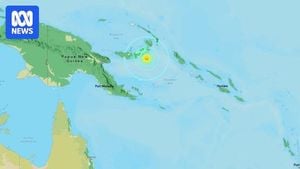A powerful "bomb cyclone" storm has hit the Pacific Northwest, wreaking havoc throughout the region and leaving residents grappling with widespread power outages. This severe weather event, which occurred earlier this week, resulted in more than half a million customers losing electricity at its peak, crippling homes, schools, and businesses.
The storm made its presence known on Tuesday, unleashing strong winds, heavy rain, and blanket snowfall across parts of Washington. Reports from utility trees indicated over 640,000 customers initially lost power as the storm's impact quickly translated to road closures and emergency calls.
By Thursday afternoon, Seattle City Light reported there were still 4,355 customers without power across 224 active outages mainly concentrated in North and South Seattle. Many crews worked around the clock, restoring power to over 100,000 customers; yet fatigue remained evident as they faced the task of addressing the more stubborn outages.
For those still without power, Seattle City Light suggested preparing for continued disruptions. Their recommendations included securing outdoor items and stocking emergency kits, as the National Weather Service warned of another incoming windstorm. This new system, amounting to gusts of up to 35 mph, is projected to blow through the Seattle region on Friday morning, potentially exacerbizing the existing power challenges.
Such weather has prompted Seattle officials to encourage residents to be vigilant. Downed power lines and fallen tree branches pose safety hazards, and precautionary measures remain the best route for individuals trying to avoid the storm's wrath. For help during outages, residents are urged to report their issues directly to utility by calling their support lines.
Interestingly, this bomb cyclone has triggered more than just power problems; it has also affected the demand for electricity. Amid the chaos, electric vehicle (EV) drivers increasingly sought public charging stations as home power disruptions surfaced. Not only did this force drivers to queue for limited charging spots, but it also showcased the region's growing reliance on electric vehicles.
Brian Grunkemeyer, CEO of FlexCharging, revealed, "We’ve seen some chargers, which are typically seldom used, are seeing their spots now being fully occupied by EV drivers." Social media captured images of long lines at charging stations as drivers scrambled to fill up their batteries. Reports indicated greater traffic at fast-charging locations like those near Northgate, reflecting the direct effects of the storm on urban infrastructure.
Yet, the storm did not just impact electric vehicle users. Gas stations suffered similar fates due to the overwhelming power outages. Various locations across the region faced disruptions, leaving many gas pumps inactive just as drivers needed them most. Photos circulating on social media highlighted significant lines at gas stations as motorists scrambled to refuel.
Among the hardest-hit locations, Issaquah—a city approximately 20 miles east of Seattle—saw its roads littered with obstructive branches and bushes forced down by fierce winds. There, the community came together seeking refuge at local emergency centers which provided warmth and temporary shelter during the tumultuous weather. The situation there impacted many individuals, including local residents who felt the storm's impact deeply.
Alongside these challenges, another grim facet of the cyclone involved casualties. Sadly, reports confirmed the deaths of two women, both of whom lost their lives due to falling trees as the cyclone swept through the Seattle area. Based on information from South County Fire, one of the victims was at a homeless encampment, the other being struck inside her home.
The National Weather Service has forecasted even more unpredictable weather patterns, warning residents of another round of gusty winds and snowfall expected to settle over the weekend. Starting Friday, another storm system will swing through the Pacific Northwest front, posing more risk for downed trees, potential power disruptions, and hazardous driving conditions.
"This is not over yet," remarked meteorologists monitoring the incoming weather changes. They noted the expected storm could affect not just Washington but could spread reaching areas south to California, where the atmosphere is already heavy with moisture, raising concerns about flooding and landslides.
Compounding concerns, California braces for high winds combined with the threat of excessive rainfall due to simultaneous atmospheric river events. These massive moisture bands are notorious for funneling water vapor and wreaking havoc—significantly more so for communities still reeling from past storms.
"We’re continuing to monitor events closely," said representatives from the National Oceanic and Atmospheric Administration. They addressed potential impacts, inclusive of problematic debris flows triggered by wet conditions linked to forest fires from earlier this summer, raising alarms for public safety and rescue services.
While power companies like Puget Sound Energy engaged actively to restore outages, they stated it was one of the largest storm-induced outages the state had experienced since 2006, showing the breadth of its effects.
Schools in the region also faced closures due to the extensive damages and power outages. Districts like Bellevue found many of their facilities unable to accommodate students as they struggled for power beyond Thursday, raising concerns about reopening safely for upcoming classes.
For healthcare facilities, the reliance on backup generators became increasingly necessary as storm-related injuries surged among patients seeking emergency treatment for various storm-induced incidents.
With the region's infrastructure again placed at risk, officials pressed residents to engage with alert updates and required assistance as they braced for potential repercussions.
Weather officials are urging community members to stay informed on the latest developments and be prepared for unexpected changes. Those facing challenging conditions due to the cyclone are advised to check their providers for nearest charging options, community resources, potential shelter locations, and emergency updates whether through social media channels, utility notifications, or community boards.



